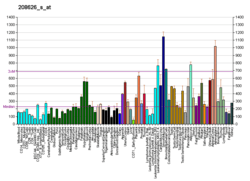VAT1
| VAT1 | |||||||||||||||||||||||||
|---|---|---|---|---|---|---|---|---|---|---|---|---|---|---|---|---|---|---|---|---|---|---|---|---|---|
| Identifiers | |||||||||||||||||||||||||
| Aliases | VAT1, VATI, vesicle amine transport 1 | ||||||||||||||||||||||||
| External IDs | MGI: 1349450 HomoloGene: 36200 GeneCards: VAT1 | ||||||||||||||||||||||||
| |||||||||||||||||||||||||
| |||||||||||||||||||||||||
| |||||||||||||||||||||||||
| |||||||||||||||||||||||||
| Orthologs | |||||||||||||||||||||||||
| Species | Human | Mouse | |||||||||||||||||||||||
| Entrez | |||||||||||||||||||||||||
| Ensembl | |||||||||||||||||||||||||
| UniProt | |||||||||||||||||||||||||
| RefSeq (mRNA) | |||||||||||||||||||||||||
| RefSeq (protein) | |||||||||||||||||||||||||
| Location (UCSC) | Chr 17: 43.01 – 43.03 Mb | Chr 11: 101.46 – 101.47 Mb | |||||||||||||||||||||||
| PubMed search | [3] | [4] | |||||||||||||||||||||||
| Wikidata | |||||||||||||||||||||||||
| |||||||||||||||||||||||||
Synaptic vesicle membrane protein VAT-1 homolog is a protein that in humans is encoded by the VAT1 gene.[5][6][7]
Synaptic vesicles are responsible for regulating the storage and release of neurotransmitters in the nerve terminal. The protein encoded by this gene is an abundant integral membrane protein of cholinergic synaptic vesicles and is thought to be involved in vesicular transport. It belongs to the quinone oxidoreductase subfamily of zinc-containing alcohol dehydrogenase proteins.[7]
In melanocytic cells VAT1 gene expression may be regulated by MITF.[8]
References
- 1 2 3 GRCh38: Ensembl release 89: ENSG00000108828 - Ensembl, May 2017
- 1 2 3 GRCm38: Ensembl release 89: ENSMUSG00000034993 - Ensembl, May 2017
- ↑ "Human PubMed Reference:".
- ↑ "Mouse PubMed Reference:".
- ↑ Friedman LS, Ostermeyer EA, Lynch ED, Welcsh P, Szabo CI, Meza JE, Anderson LA, Dowd P, Lee MK, Rowell SE, et al. (Jul 1995). "22 genes from chromosome 17q21: cloning, sequencing, and characterization of mutations in breast cancer families and tumors". Genomics. 25 (1): 256–63. doi:10.1016/0888-7543(95)80133-7. PMID 7774926.
- ↑ Smith TM, Lee MK, Szabo CI, Jerome N, McEuen M, Taylor M, Hood L, King MC (Feb 1997). "Complete genomic sequence and analysis of 117 kb of human DNA containing the gene BRCA1". Genome Res. 6 (11): 1029–49. doi:10.1101/gr.6.11.1029. PMID 8938427.
- 1 2 "Entrez Gene: VAT1 vesicle amine transport protein 1 homolog (T. californica)".
- ↑ Hoek KS, Schlegel NC, Eichhoff OM, et al. (2008). "Novel MITF targets identified using a two-step DNA microarray strategy". Pigment Cell Melanoma Res. 21 (6): 665–76. doi:10.1111/j.1755-148X.2008.00505.x. PMID 19067971.
Further reading
- Miki Y, Swensen J, Shattuck-Eidens D, et al. (1994). "A strong candidate for the breast and ovarian cancer susceptibility gene BRCA1". Science. 266 (5182): 66–71. doi:10.1126/science.7545954. PMID 7545954.
- Harshman K, Bell R, Rosenthal J, et al. (1995). "Comparison of the positional cloning methods used to isolate the BRCA1 gene". Hum. Mol. Genet. 4 (8): 1259–66. doi:10.1093/hmg/4.8.1259. PMID 7581362.
- Friedman LS, Ostermeyer EA, Lynch ED, et al. (1995). "The search for BRCA1". Cancer Res. 54 (24): 6374–82. PMID 7987831.
- Matoba R, Okubo K, Hori N, et al. (1994). "The addition of 5'-coding information to a 3'-directed cDNA library improves analysis of gene expression". Gene. 146 (2): 199–207. doi:10.1016/0378-1119(94)90293-3. PMID 8076819.
- Strausberg RL, Feingold EA, Grouse LH, et al. (2003). "Generation and initial analysis of more than 15,000 full-length human and mouse cDNA sequences". Proc. Natl. Acad. Sci. U.S.A. 99 (26): 16899–903. doi:10.1073/pnas.242603899. PMC 139241. PMID 12477932.
- Ota T, Suzuki Y, Nishikawa T, et al. (2004). "Complete sequencing and characterization of 21,243 full-length human cDNAs". Nat. Genet. 36 (1): 40–5. doi:10.1038/ng1285. PMID 14702039.
- Gerhard DS, Wagner L, Feingold EA, et al. (2004). "The status, quality, and expansion of the NIH full-length cDNA project: the Mammalian Gene Collection (MGC)". Genome Res. 14 (10B): 2121–7. doi:10.1101/gr.2596504. PMC 528928. PMID 15489334.
This article is issued from
Wikipedia.
The text is licensed under Creative Commons - Attribution - Sharealike.
Additional terms may apply for the media files.




